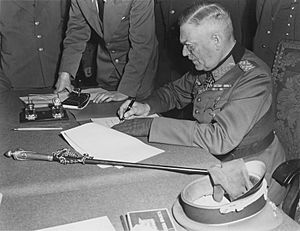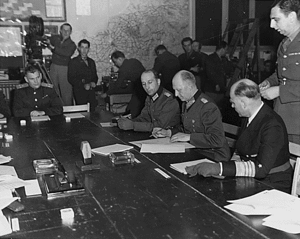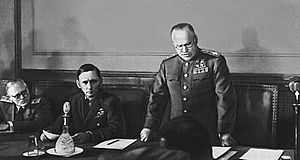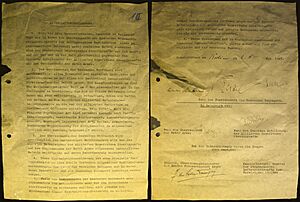German Instrument of Surrender facts for kids
| The capitulation of the German state to the conditions provided by the Allies | |
|---|---|

Field-Marshal Wilhelm Keitel signing the unconditional surrender document, 8 May 1945
|
|
| Type | Capitulation |
| Signed | 8 May 1945 |
| Location | Berlin, Germany |
| Condition | Signed |
| Signatories | |
| Parties | |
| Ratifiers |
|

The German Instrument of Surrender was a very important legal document. It officially marked the unconditional surrender of Germany's armed forces to the Allied Powers. This event finally ended World War II in Europe. The surrender became active at 11:01 PM Central European Time on May 8, 1945.
Germany had signed a similar document the day before in Reims, France. However, the Soviet Union did not accept this first signing. They wanted a new document signed in Berlin. Also, after the first signing, German forces were told to stop fighting in the west but keep fighting in the east.
So, Germany, under its new leader Karl Dönitz, agreed to sign a second document. This signing happened in Berlin, at the Soviet military headquarters. Representatives from the German High Command, the British, and the Soviet Union signed it. French and American representatives signed as witnesses. Wilhelm Keitel, a top German military leader, was the main German signer. This final surrender led to the end of Nazi Germany. The Allies then took control of Germany.
The surrender document was written in three languages: English, Russian, and German. The English and Russian versions were the official ones.
Contents
Why Did Germany Surrender?
On April 30, 1945, Germany's leader, Adolf Hitler, died by suicide. He had named Admiral Karl Dönitz as the new head of Germany. Soon after, Berlin fell to Allied forces. American and Soviet troops met at the Elbe River. This split the remaining German-controlled areas into two parts.
Most German forces were stuck in isolated areas. Dönitz tried to form a new government in Flensburg, near the Danish border. He wanted his government to seem "unpolitical." However, he did not ban the Nazi Party or arrest Nazi leaders. Because of this, the Allies did not see his government as truly representing Germany.
German armies were still fighting in many places. These included parts of France, Greece, Norway, Denmark, the Netherlands, Italy, Austria, and Czechoslovakia. They also fought in parts of Germany itself.
What Was the Surrender Document?
Allied representatives from the Soviet Union, the United States, and the United Kingdom worked together. They started preparing a surrender document in 1944. They wanted a single document for Germany's unconditional surrender.
They suggested that German military leaders should sign the document. This was to prevent a repeat of the "stab-in-the-back myth" from World War I. After that war, some Germans claimed that civilians, not the military, were responsible for the defeat.
The Allies agreed on a three-part document on July 28, 1944.
- The first part was a short introduction. It stated that Germany recognized its complete defeat. It announced Germany's unconditional surrender.
- The second part (articles 1-5) covered the military surrender. This included giving up weapons and becoming prisoners of war.
- The third part (articles 6-12) dealt with Germany giving up its power to the Allies. It also covered releasing prisoners and stopping radio broadcasts. It mentioned handing over Nazi leaders for war crimes trials.
A very important part was Article 12. It said Germany would follow all orders from the Allied representatives. This allowed the Allies to make many rules for Germany's future.
At the Yalta Conference in February 1945, the Allies decided to divide Germany into four zones. These zones would be controlled by the Soviet Union, Britain, France, and the United States. They also thought about adding a clause about disarming and breaking up Germany. However, France did not agree to this part.
By March 1945, the British wondered if any German government would be left to sign the surrender. They suggested the Allies should just declare Germany defeated. This led to the Declaration Regarding the Defeat of Germany.
The Allies also agreed on rules for local military surrenders. These had to be unconditional. They were only about military matters. These local surrenders would not affect the main, overall surrender document.
Smaller Surrenders Before the Main One
Before the final surrender, some German forces gave up in different areas.
German Forces in Italy and Western Austria
German military leaders in Italy secretly negotiated a surrender. It was signed on April 29, 1945. It became active on May 2.
German Forces in Northwest Germany, Netherlands, Denmark, and Schleswig-Holstein
On May 4, 1945, German forces facing British and Canadian troops surrendered. This happened at Lüneburg Heath. It became active on May 5.
German Forces in Southern Germany
On May 5, 1945, all German forces in Bavaria and Southwest Germany surrendered to the Americans. This happened near Munich. It became active on May 6.
Admiral Dönitz wanted to save as many German soldiers as possible from Soviet capture. He ordered his troops to surrender to the British and Americans in the west. He hoped to move soldiers and civilians away from the east by sea. Dönitz and Keitel did not want to surrender to the Soviets. They feared their orders would not be followed.
These surrenders stopped fighting between German forces and the Western Allies. However, fighting continued in the east. German forces were still told to fight their way west. Allied commander Eisenhower realized this could make the Soviets think the Western Allies were making a separate peace. So, he insisted on a general surrender of all German forces to all Allied powers, including the Soviets.
German Army Group Ostmark
To avoid Soviet capture, Army Group Ostmark surrendered to American forces in Austria. This happened on May 7, 1945. It became active on May 8.
After these smaller surrenders, Germany signed its final surrender document in Berlin.
The Surrender Ceremonies
First Surrender Document in Reims

Admiral Hans-Georg von Friedeburg, representing Dönitz, was told that Eisenhower wanted an "immediate, simultaneous and unconditional surrender on all fronts." General Alfred Jodl was sent to Reims to argue against this. But Eisenhower said that if Germany did not surrender completely, he would close Allied lines to German forces and restart bombing.
Jodl told Dönitz this news. Dönitz then allowed Jodl to sign the unconditional surrender. He asked for a 48-hour delay. This was supposedly to tell all German units about the surrender.
So, the first surrender document was signed in Reims at 2:41 AM on May 7, 1945. It was signed in a schoolhouse that was the Allied headquarters. It was set to become active at 11:01 PM on May 8. The 48-hour delay was counted from the start of the final talks.
Jodl signed for the German High Command. Walter Bedell Smith signed for the Western Allies. General Ivan Susloparov signed for the Soviet High Command. French Major-General François Sevez signed as a witness.
Eisenhower had talked with Soviet General Aleksei Antonov. Susloparov was there to represent the Soviets. However, the Soviets had not fully approved the text or Susloparov's power to sign. So, Eisenhower and Susloparov agreed that the Germans would also sign a promise. This promise said that fully authorized German leaders would attend a formal signing later.
Final Surrender Document in Berlin

About six hours after the Reims signing, the Soviets responded. They said the surrender was not acceptable. They said the text was different from what was agreed. Also, Susloparov was not fully authorized. The real reason was that the Soviets wanted the main surrender to be a unique, historic event. They wanted it to happen in Berlin, the capital of Nazi Germany. They also wanted it to clearly state that German troops must lay down their arms and become prisoners.
Eisenhower agreed. He said the Reims signing was a "brief instrument of unconditional military surrender." He promised to attend a "more formal signing" in Berlin. This would be led by Marshal Georgy Zhukov. Eisenhower also said that any German forces still fighting the Soviets after the deadline would "no longer have the status of soldiers." If they surrendered to the Americans or British, they would be handed over to the Soviets.
The Reims signing mainly created a ceasefire between German forces and the Western Allies. But fighting continued in the east. Dönitz ordered his troops to keep fighting the Soviets. He used the 48-hour grace period to try and save more German units from Soviet capture. It became clear that Dönitz had signed in Reims without full intention of stopping all fighting.
So, Eisenhower arranged for the top German military leaders to fly to Berlin on May 8. They waited until 10:00 PM when the Allied delegation arrived. They were given the updated surrender text. The final Act of Military Surrender was signed just before midnight on May 8. It happened at the Soviet Military Administration in Berlin-Karlshorst.
Since Eisenhower outranked Zhukov, his deputy, Air Chief Marshal Arthur Tedder, signed for the Western Allies. The Soviets wanted only three Allied signers, with Zhukov being one. After many changes, it was agreed that French and American generals would sign as witnesses. Because of all the changes and translations, the actual signing happened almost at 1:00 AM on May 9. But it was officially dated May 8 to match the Reims agreement and public announcements. The Soviet official report said the signing happened at 10:43 PM on May 8.
The final surrender document was different from the Reims one. It needed three German signers to represent all three armed services and the German High Command. It also added a rule (Article 2) that German forces must disarm and hand over their weapons. This meant German troops would not only stop fighting but also give up and become prisoners. Field Marshal Keitel at first did not want to sign. He asked for another 12-hour grace period. But Zhukov gave him a verbal promise instead.
The document stated:
- Germany surrenders unconditionally to the Allied Expeditionary Force and the Soviet Red Army.
- German forces must stop fighting at 11:01 PM on May 8, 1945. They must stay in their positions and disarm completely.
- The German High Command must follow all further orders from the Allied commanders.
- This surrender does not affect any future, more general surrender document for all of Germany.
- If Germany does not follow this act, the Allies can take action.
- The English and Russian versions are the only official texts.
The signers were:
- Soviet Union: Marshal Georgy Zhukov
- United Kingdom: Air Chief Marshal Sir Arthur William Tedder
- United States: General Carl Spaatz (witness)
- France: General Jean de Lattre de Tassigny (witness)
- Germany:
- Field Marshal Wilhelm Keitel (German Armed Forces)
- General-Admiral Hans-Georg von Friedeburg (German Navy)
- Colonel-General Hans-Jürgen Stumpff (German Air Force)
Admiral Friedeburg was the only German representative present at all three surrender signings: Lüneburg Heath, Reims, and Berlin.
The Berlin signing mostly worked. German forces in many areas surrendered on May 9. However, some German forces in Czechoslovakia kept fighting. They tried to reach American lines. But the general surrender rule held. Units trying to defy it were not allowed to pass west. They had to surrender to the Soviets. One exception was Army Group E in Croatia. They fought for several days to escape Yugoslav forces. Many of these soldiers did surrender to General Harold Alexander in Italy.
| Events | GMT-4 Eastern U.S. Time (Eastern War Time) |
GMT Universal time |
GMT+1 Time in Ireland (Summer Time) CET |
GMT+2 Time observed in Western Europe (Germany, France, Great Britain) BDST during the war CEST (Summer Time) |
GMT+3 Time in Eastern Europe (Ukraine, Russia) |
| Signing of the capitulation in Reims |
8:41 pm Sunday 6 May |
00:41 Monday 7 May |
02:41 Monday 7 May |
03:41 Monday 7 May |
|
| End of the war announced by Truman, Churchill, de Gaulle |
9:15am Tuesday 8 May |
13:15 Tuesday 8 May |
15:15 Tuesday 8 May |
||
| New signing of the capitulation in Berlin |
5:43pm Tuesday 8 May |
21:43 Tuesday 8 May |
22:43 Tuesday 8 May |
23:43 Tuesday 8 May |
00:43 Wednesday 9 May |
| Moment of the ceasefire as agreed in Reims |
6:01pm Tuesday 8 May |
22:01 Tuesday 8 May |
23:01 Tuesday 8 May |
00:01 Wednesday 9 May |
01:01 Wednesday 9 May |
"VE Day" and "Victory Day"
Many reporters were at the Reims signing. They were told not to report the news for 36 hours. But an American journalist, Edward Kennedy, broke this rule on May 7. So, the German surrender became headline news in the west on May 8.
Because the news was out, Western Allies decided to celebrate "Victory in Europe Day" (VE Day) on May 8. Western leaders made their formal announcements that evening. The Soviet government did not publicly acknowledge the Reims signing. The Soviet Union celebrated "Victory Day" on May 9, 1945. This was because the Berlin document was signed when it was already May 9 in the Soviet Union. Today, both May 8 and May 9 are considered the end of World War II in Europe due to time zone differences.
What Happened After the Surrender?
The Allied governments did not recognize Admiral Dönitz's government as the true government of Germany. So, the German signers of the surrender document officially represented only the German High Command. On May 23, 1945, Dönitz and other former Nazi members were arrested. Admiral Friedeburg died by suicide.
On June 5, 1945, the Berlin Declaration was made. This confirmed Germany's defeat and the end of Nazi rule. It also established the Allied occupation of Germany.
Germany's Diplomatic Status
Before the surrender, many countries had closed their German embassies. After the surrender, the Allies stated that Germany's identity would now rest with the four Allied Powers. They recalled all German diplomatic staff. They took control of German state property. This meant that Germany stopped being a diplomatic entity on May 8, 1945. It remained this way until West Germany was formed on May 23, 1949.
Berlin Declaration (June 5, 1945)
The surrender document on May 8, 1945, was signed only by German military leaders. So, the Allies needed a formal way to show Germany's complete surrender. They rewrote the EAC text as a declaration. This became the Declaration regarding the defeat of Germany.
This declaration stated that Germany had no government or central authority. The Allies did not recognize Dönitz's government. So, the four Allied Powers (Soviet Union, United States, United Kingdom, and France) took over all civil authority in Germany. This authority later became the Allied Control Council (ACC).
Images for kids
-
British Field-Marshal Bernard Montgomery (seated second from the right) signs the terms of the surrender watched by Rear Admiral Wagner and Admiral von Friedeburg on May 4, 1945.
See Also
- Timeline of the surrender of Axis forces at the end of World War II
- Japanese Instrument of Surrender
- Nuremberg trials





